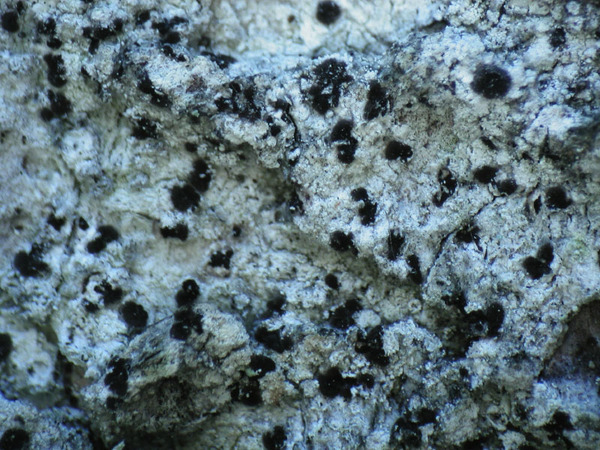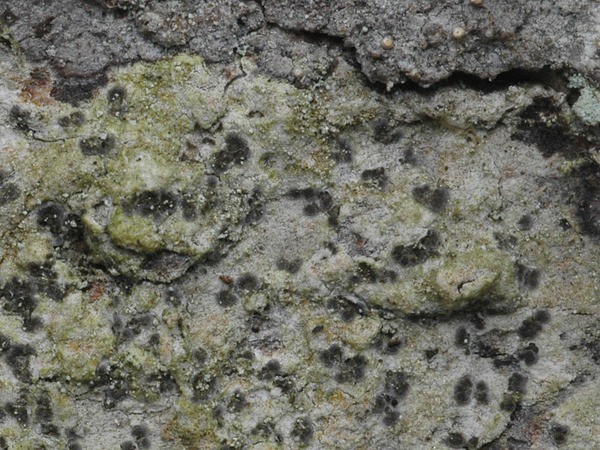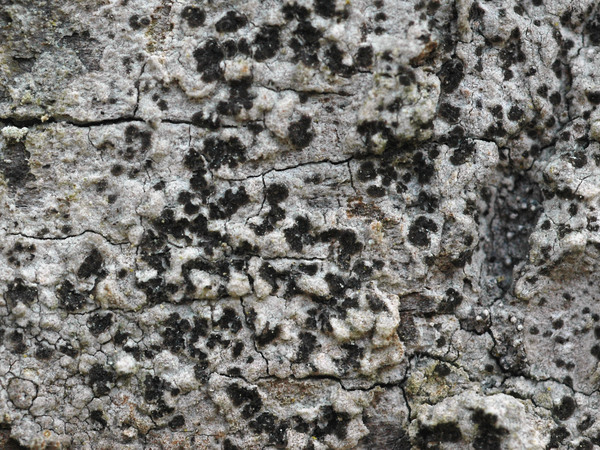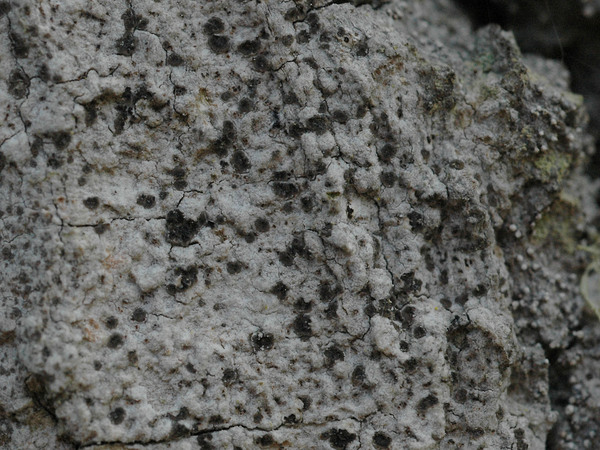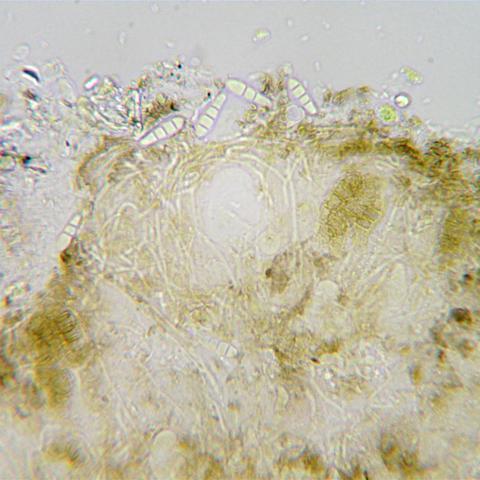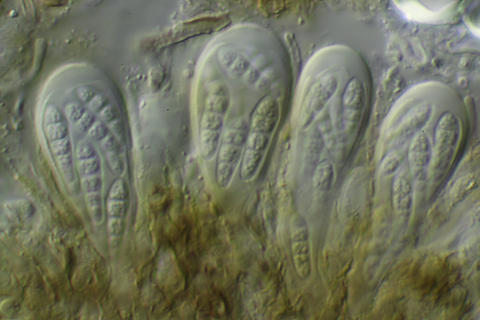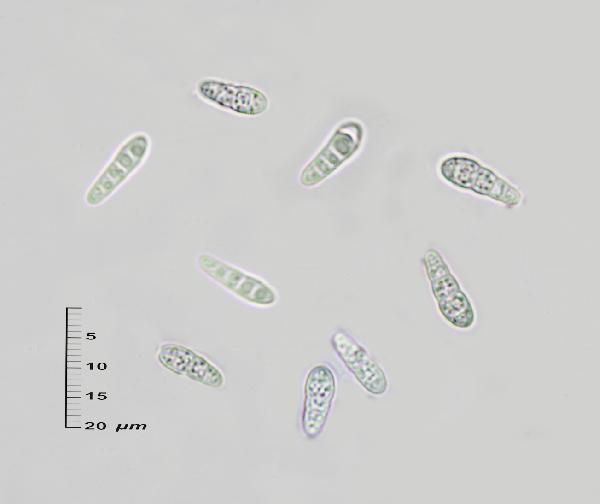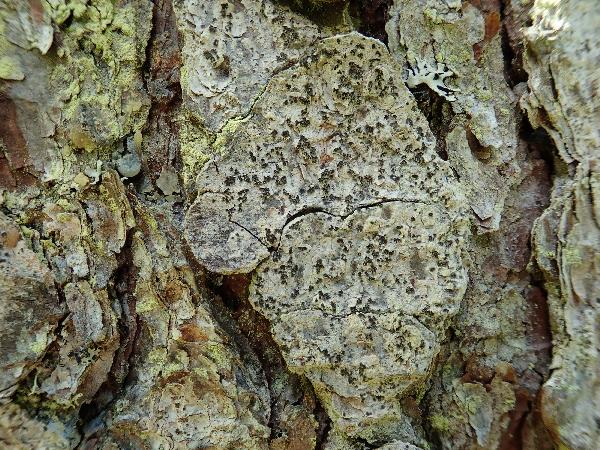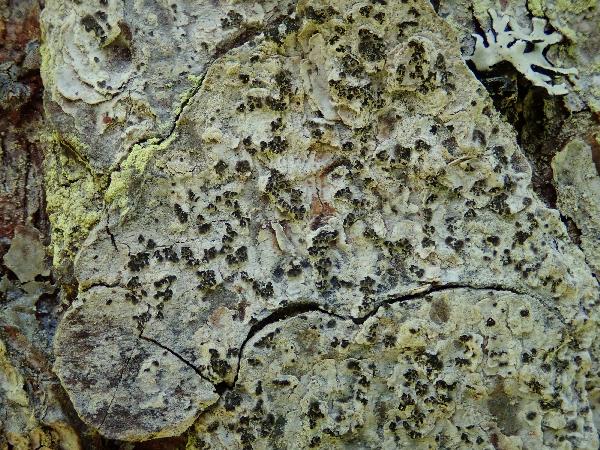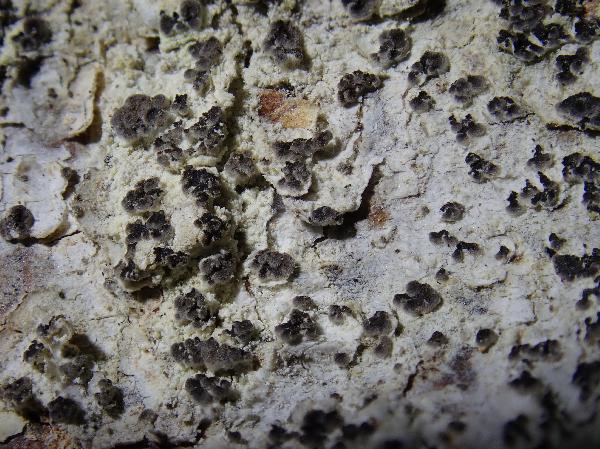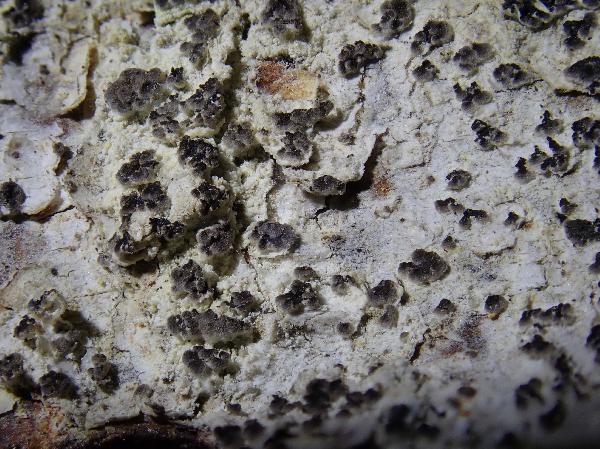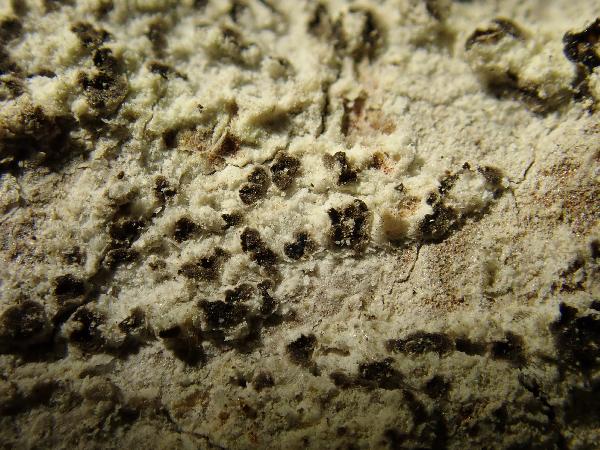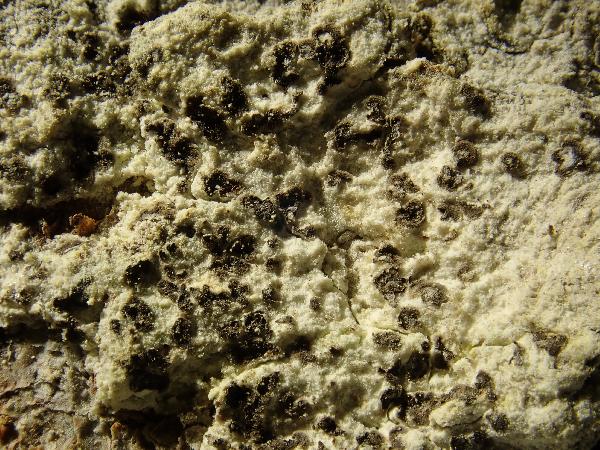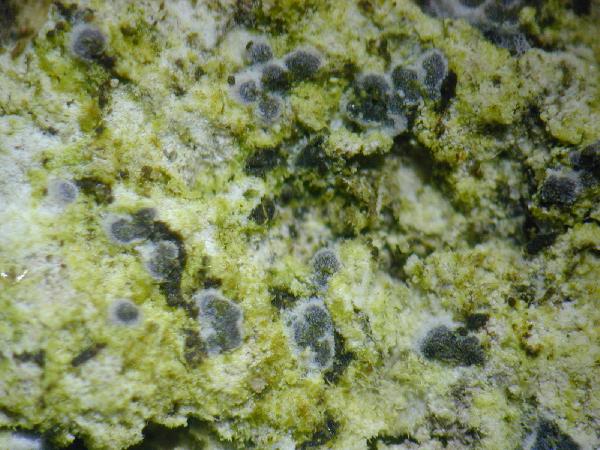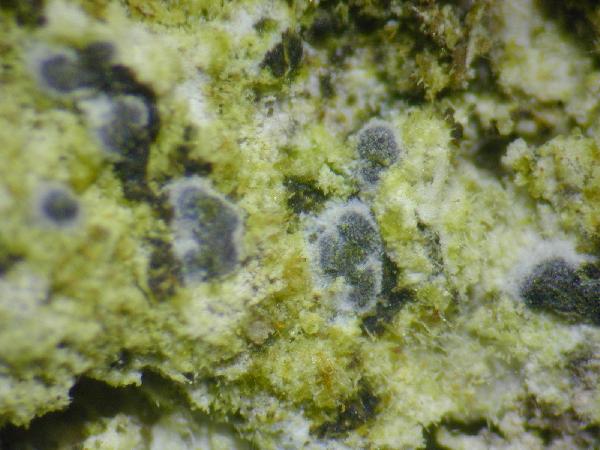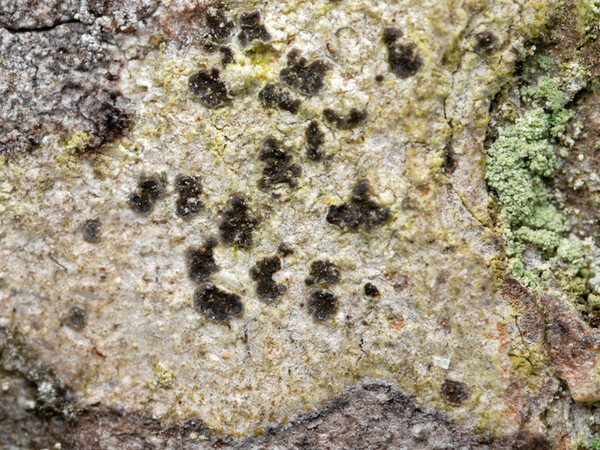Felipes leucopellaeus (Ach.) Frisch & G. Thor
in Frisch & al., Taxon, 63: 738, 2014. Basionym: Spiloma melaleucum var. leucopellaeum Ach. - Lichenogr. Univ.: 138, 1810.
Synonyms: Arthonia leucopellaea (Ach.) Almq.; Arthonia marmorata Nyl.; Arthonia melaleuca sensu Malme; Arthonia schaereri A. Massal.; Melaspilea associata Norman; Trachylia leucopellaea (Ach.) Eitner
Distribution: N - Frl. C - Sar (Cossu 2013).
Description: Thallus crustose, white to pale yellowish white, smooth to granulose or arachnoid, sometimes inapparent, the hyphae K/I-. Apothecia 1-2 mm across, irregularly rounded to weakly lobed or star-shaped, sometimes short-lirelliform, with a dark brown to black, but more or less grey-pruinose disc and a somewhat arachnoid, slightly prominent, whitish marginal zone. Proper exciple dark brown, of densely entangled hyphae, with a marginal layer of hyaline to pale brown, branched and anastomosing hyphae with cylindrical cells; epithecium brown, K+ yellowish green; hymenium colourless to pale yellowish brown, 25-60 μm high, weakly amyloid; paraphysoids strongly coherent, brown-walled, 1-1.5 μm thick in lower part, the apical cells up to 2 μm wide, without a dark cap, the densely intertwined tips often extending horizontally; hypothecium dark brown, 35-70 µm high. Asci 8-spored, broadly clavate, semi-fissitunicate, with a large apical dome and a distinct ocular chamber, lacking hemiamyloid tholus structures. Ascospores 3-4-septate, hyaline (but overmature spores often brownish and finely warted), oblong-ovoid, widest above the middle, (9-)11-17(-19) x 3-5.5 µm, with subequal cells. Photobiont trentepohlioid, the cells thick-walled, 15-40 x 8-30 μm. Spot tests: thallus K+ pale pale yellow to brownish orange, C-, KC-, P- or P+ orange, UV-. Chemistry: two unknown substances in thallus.Note: on bark of conifers in old-growth forests under suboceanic climatic conditions; widespread in the temperate to boreal zones of the Holarctic region, in the Alps mainly in the montane belt, but lacking in the central Alps with more continental climate conditions. It is included in the Italian red list of epiphytic lichens as “Critically Endangered” (Nascimbene & al. 2013c).
Growth form: Crustose
Substrata: bark
Photobiont: Trentepohlia
Reproductive strategy: mainly sexual
Most common in areas with a humid-warm climate (e.g. most of Tyrrenian Italy)
Commonnes-rarity: (info)
Alpine belt: absent
Subalpine belt: absent
Oromediterranean belt: absent
Montane belt: extremely rare
Submediterranean belt: absent
Padanian area: absent
Humid submediterranean belt: absent
Humid mediterranean belt: absent
Dry mediterranean belt: absent
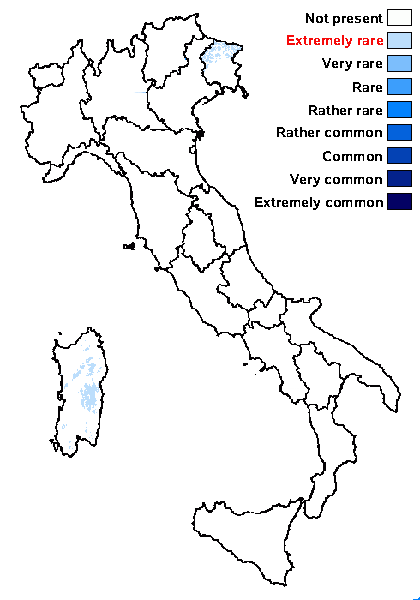
Predictive model
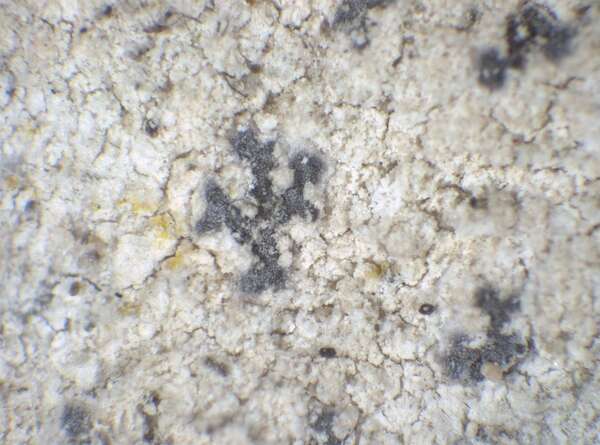

P.L. Nimis; Owner: Department of Life Sciences, University of Trieste
Herbarium: TSB (5120)
2003/01/23
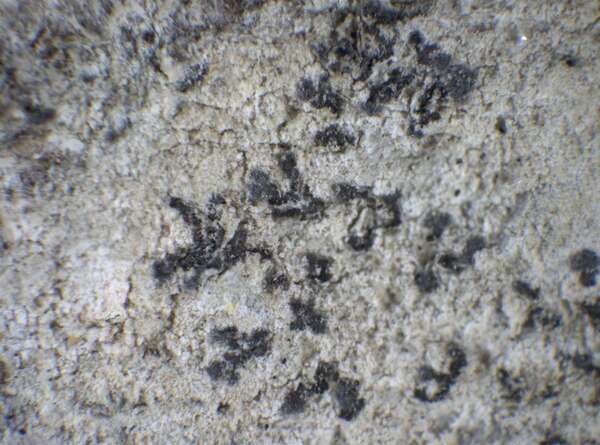

P.L. Nimis; Owner: Department of Life Sciences, University of Trieste
Herbarium: TSB (5120)
2001/11/21
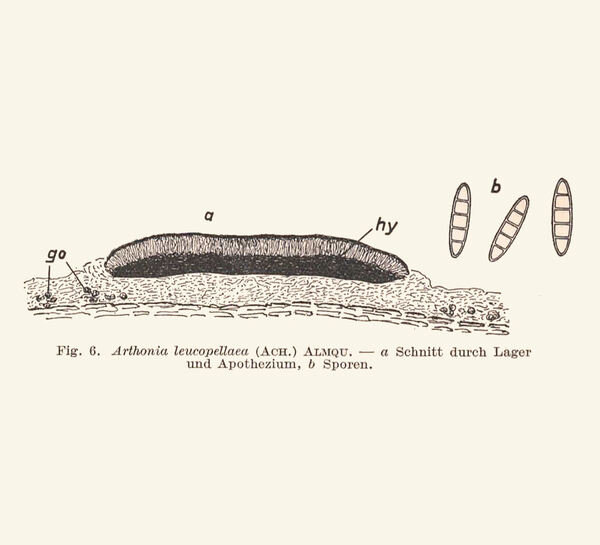
Redinger, K. (1938) Arthoniaceae, Graphidaceae . In Kryptogamen-Flora von Deutschland, Österreich und der Schweiz. Band 9, 2 Abt., Part 1 (G. L. Rabenhorst, ed.): 181–404. Leipzig: Borntraeger

Bernard Bouffinier - Source: http://www.lichensmaritimes.org/index.php?task=fiche&lichen=819&lang=en
France, Sur l'écorce du tronc d'un vieux Pinus Pointe de la Jument
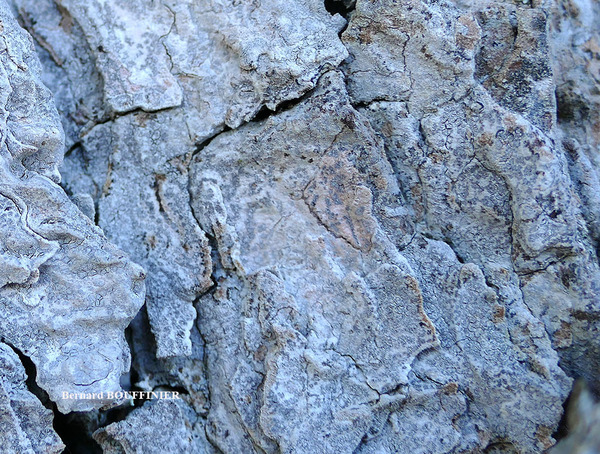
Bernard Bouffinier - Source: http://www.lichensmaritimes.org/index.php?task=fiche&lichen=819&lang=en
France, Sur l'écorce du tronc d'un vieux Pinus Pointe de la Jument
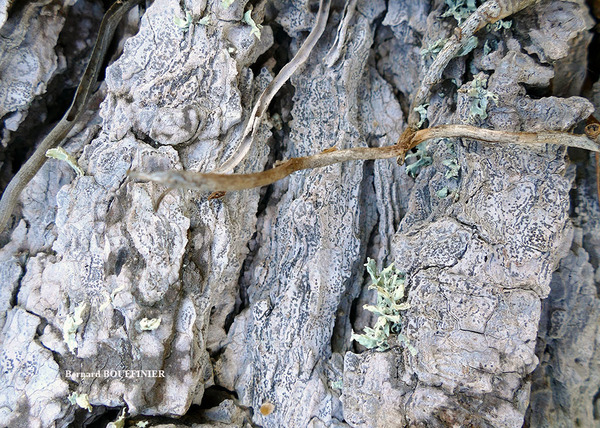
Bernard Bouffinier - Source: http://www.lichensmaritimes.org/index.php?task=fiche&lichen=819&lang=en
France, Sur l'écorce du tronc d'un vieux Pinus Pointe de la Jument
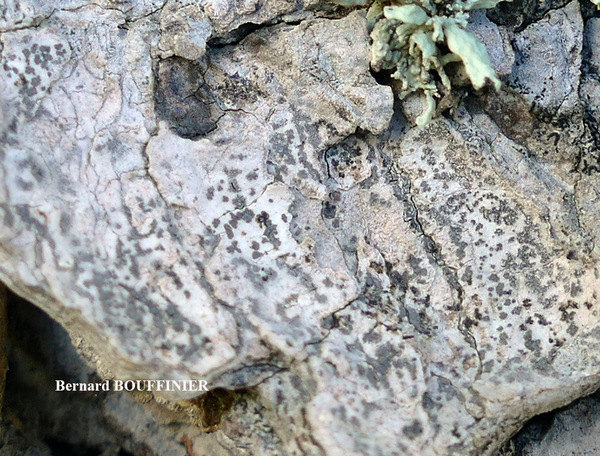
Bernard Bouffinier - Source: http://www.lichensmaritimes.org/index.php?task=fiche&lichen=819&lang=en
France, Sur l'écorce du tronc d'un vieux Pinus Pointe de la Jument
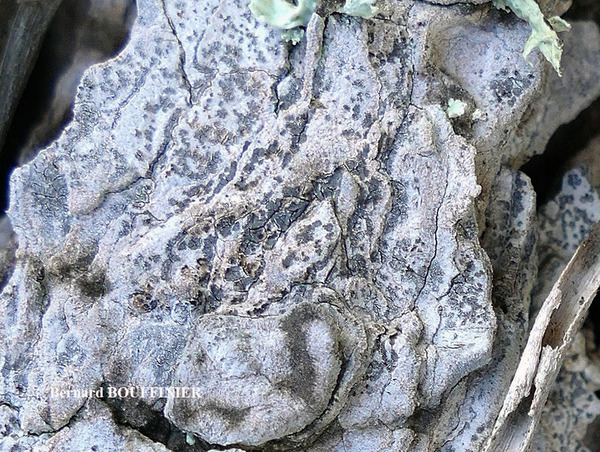
Bernard Bouffinier - Source: http://www.lichensmaritimes.org/index.php?task=fiche&lichen=819&lang=en
France, Sur l'écorce du tronc d'un vieux Pinus Pointe de la Jument
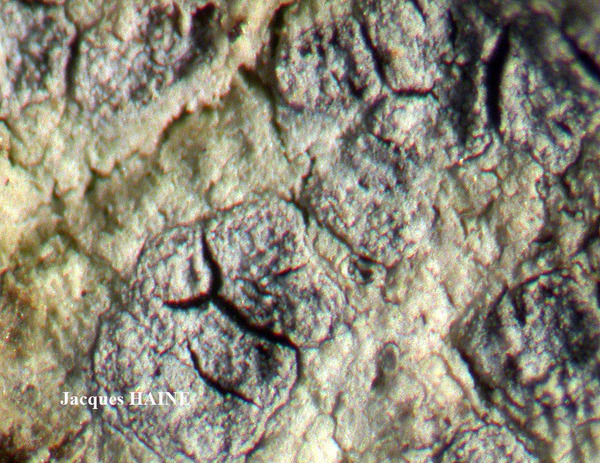
Jacques Haine - Source: http://www.lichensmaritimes.org/index.php?task=fiche&lichen=819&lang=en
France, Sur l'écorce du tronc d'un vieux Pinus Pointe de la Jument
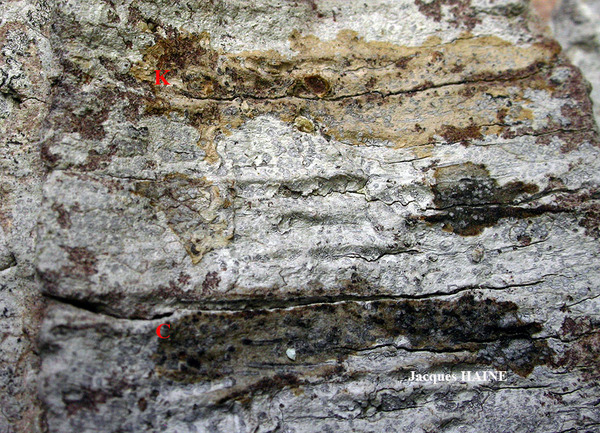
Jacques Haine - Source: http://www.lichensmaritimes.org/index.php?task=fiche&lichen=819&lang=en
France, Sur l'écorce du tronc d'un vieux Pinus Pointe de la Jument
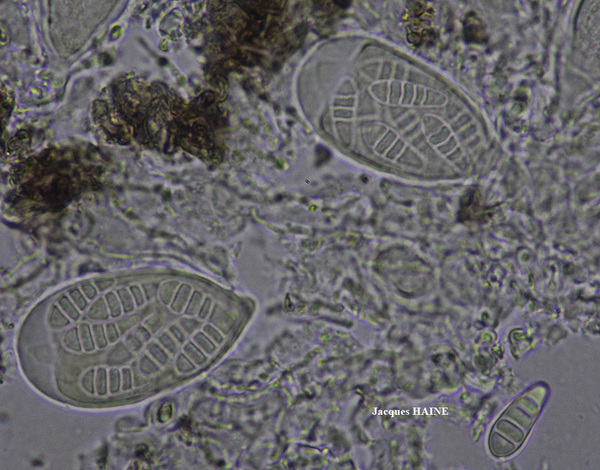
Jacques Haine - Source: http://www.lichensmaritimes.org/index.php?task=fiche&lichen=819&lang=en
France, Sur l'écorce du tronc d'un vieux Pinus Pointe de la Jument
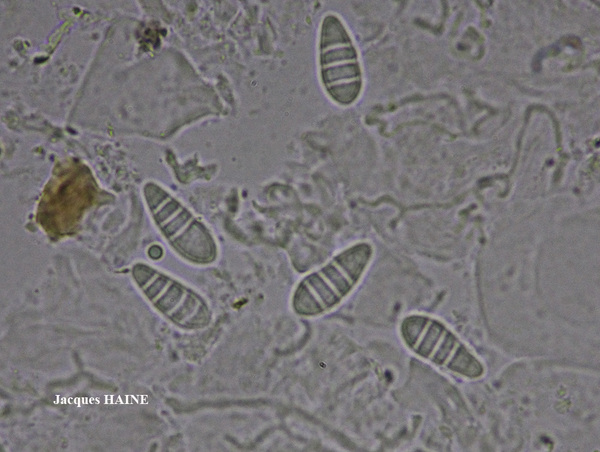
Jacques Haine - Source: http://www.lichensmaritimes.org/index.php?task=fiche&lichen=819&lang=en
France, Sur l'écorce du tronc d'un vieux Pinus Pointe de la Jument

Marta Gonzalez Garcia - Centro de Estudios Micologicos Asturianos
Spain, Subida a la Laguna de Reconco, Guillón (Cangas del Narcea-Asturias), 18-VI-2022, en corteza de Ilex aquifolium, leg. J. Linde, det. M. González, ERD-9449.
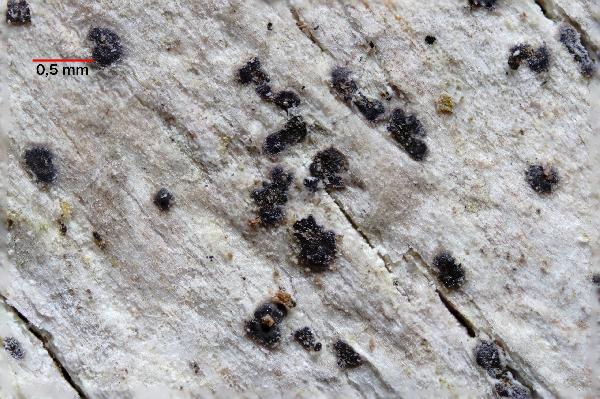
Marta Gonzalez Garcia - Centro de Estudios Micologicos Asturianos
Spain, Subida a la Laguna de Reconco, Guillón (Cangas del Narcea-Asturias), 18-VI-2022, en corteza de Ilex aquifolium, leg. J. Linde, det. M. González, ERD-9449.
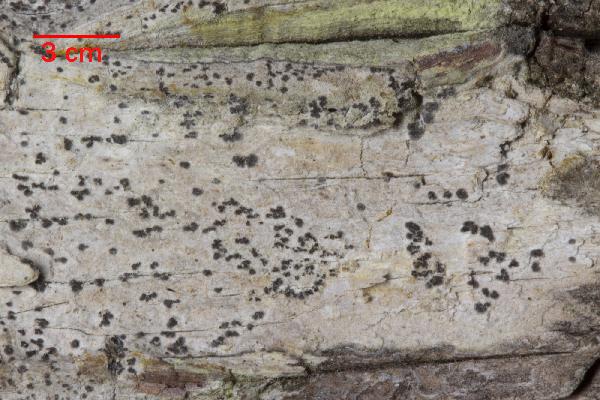
Marta Gonzalez Garcia - Centro de Estudios Micologicos Asturianos
Spain, Subida a la Laguna de Reconco, Guillón (Cangas del Narcea-Asturias), 18-VI-2022, en corteza de Ilex aquifolium, leg. J. Linde, det. M. González, ERD-9449.

Marta Gonzalez Garcia - Centro de Estudios Micologicos Asturianos
Spain, Subida a la Laguna de Reconco, Guillón (Cangas del Narcea-Asturias), 18-VI-2022, en corteza de Ilex aquifolium, leg. J. Linde, det. M. González, ERD-9449.

Marta Gonzalez Garcia - Centro de Estudios Micologicos Asturianos
Spain, Subida a la Laguna de Reconco, Guillón (Cangas del Narcea-Asturias), 18-VI-2022, en corteza de Ilex aquifolium, leg. J. Linde, det. M. González, ERD-9449.
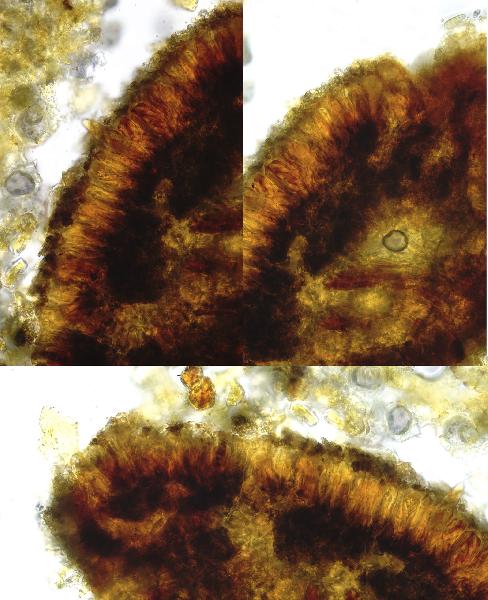
Marta Gonzalez Garcia - Centro de Estudios Micologicos Asturianos
Spain, Subida a la Laguna de Reconco, Guillón (Cangas del Narcea-Asturias), 18-VI-2022, en corteza de Ilex aquifolium, leg. J. Linde, det. M. González, ERD-9449.
Growth form: Crustose
Substrata: bark
Photobiont: Trentepohlia
Reproductive strategy: mainly sexual
Most common in areas with a humid-warm climate (e.g. most of Tyrrenian Italy)
Commonnes-rarity: (info)
Alpine belt: absent
Subalpine belt: absent
Oromediterranean belt: absent
Montane belt: extremely rare
Submediterranean belt: absent
Padanian area: absent
Humid submediterranean belt: absent
Humid mediterranean belt: absent
Dry mediterranean belt: absent

Predictive model


P.L. Nimis; Owner: Department of Life Sciences, University of Trieste
Herbarium: TSB (5120)
2003/01/23


P.L. Nimis; Owner: Department of Life Sciences, University of Trieste
Herbarium: TSB (5120)
2001/11/21

Redinger, K. (1938) Arthoniaceae, Graphidaceae . In Kryptogamen-Flora von Deutschland, Österreich und der Schweiz. Band 9, 2 Abt., Part 1 (G. L. Rabenhorst, ed.): 181–404. Leipzig: Borntraeger

Bernard Bouffinier - Source: http://www.lichensmaritimes.org/index.php?task=fiche&lichen=819&lang=en
France, Sur l'écorce du tronc d'un vieux Pinus Pointe de la Jument

Bernard Bouffinier - Source: http://www.lichensmaritimes.org/index.php?task=fiche&lichen=819&lang=en
France, Sur l'écorce du tronc d'un vieux Pinus Pointe de la Jument

Bernard Bouffinier - Source: http://www.lichensmaritimes.org/index.php?task=fiche&lichen=819&lang=en
France, Sur l'écorce du tronc d'un vieux Pinus Pointe de la Jument

Bernard Bouffinier - Source: http://www.lichensmaritimes.org/index.php?task=fiche&lichen=819&lang=en
France, Sur l'écorce du tronc d'un vieux Pinus Pointe de la Jument

Bernard Bouffinier - Source: http://www.lichensmaritimes.org/index.php?task=fiche&lichen=819&lang=en
France, Sur l'écorce du tronc d'un vieux Pinus Pointe de la Jument

Jacques Haine - Source: http://www.lichensmaritimes.org/index.php?task=fiche&lichen=819&lang=en
France, Sur l'écorce du tronc d'un vieux Pinus Pointe de la Jument

Jacques Haine - Source: http://www.lichensmaritimes.org/index.php?task=fiche&lichen=819&lang=en
France, Sur l'écorce du tronc d'un vieux Pinus Pointe de la Jument

Jacques Haine - Source: http://www.lichensmaritimes.org/index.php?task=fiche&lichen=819&lang=en
France, Sur l'écorce du tronc d'un vieux Pinus Pointe de la Jument

Jacques Haine - Source: http://www.lichensmaritimes.org/index.php?task=fiche&lichen=819&lang=en
France, Sur l'écorce du tronc d'un vieux Pinus Pointe de la Jument

Marta Gonzalez Garcia - Centro de Estudios Micologicos Asturianos
Spain, Subida a la Laguna de Reconco, Guillón (Cangas del Narcea-Asturias), 18-VI-2022, en corteza de Ilex aquifolium, leg. J. Linde, det. M. González, ERD-9449.

Marta Gonzalez Garcia - Centro de Estudios Micologicos Asturianos
Spain, Subida a la Laguna de Reconco, Guillón (Cangas del Narcea-Asturias), 18-VI-2022, en corteza de Ilex aquifolium, leg. J. Linde, det. M. González, ERD-9449.

Marta Gonzalez Garcia - Centro de Estudios Micologicos Asturianos
Spain, Subida a la Laguna de Reconco, Guillón (Cangas del Narcea-Asturias), 18-VI-2022, en corteza de Ilex aquifolium, leg. J. Linde, det. M. González, ERD-9449.

Marta Gonzalez Garcia - Centro de Estudios Micologicos Asturianos
Spain, Subida a la Laguna de Reconco, Guillón (Cangas del Narcea-Asturias), 18-VI-2022, en corteza de Ilex aquifolium, leg. J. Linde, det. M. González, ERD-9449.

Marta Gonzalez Garcia - Centro de Estudios Micologicos Asturianos
Spain, Subida a la Laguna de Reconco, Guillón (Cangas del Narcea-Asturias), 18-VI-2022, en corteza de Ilex aquifolium, leg. J. Linde, det. M. González, ERD-9449.

 INDEX FUNGORUM
INDEX FUNGORUM
 GBIF
GBIF
 DOLICHENS
DOLICHENS

